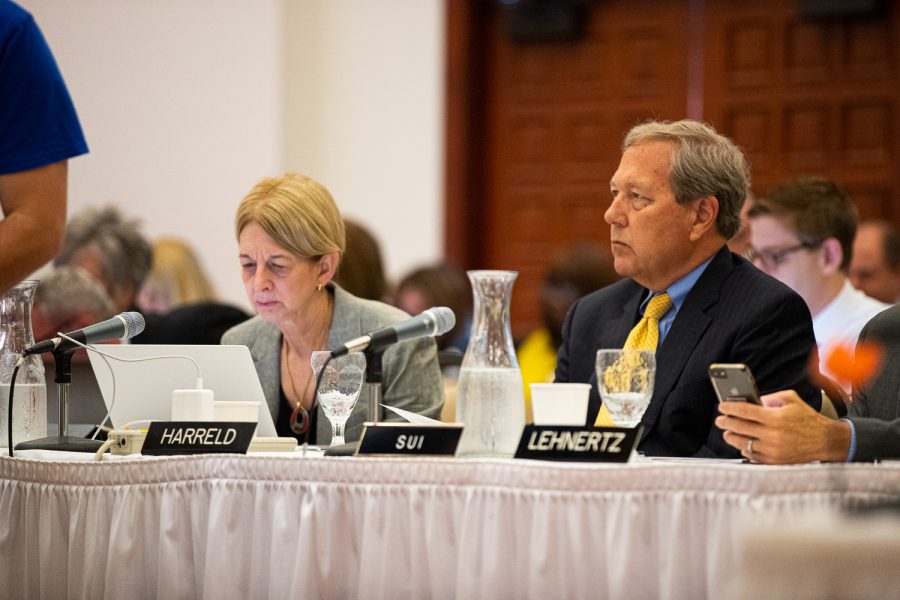Report: Iowa regent universities tout $11.8 billion impact on state economy
A report commissioned by the state Board of Regents showed Iowa’s three public universities contributed $11.8 billion to Iowa’s economy in fiscal 2018.
University of Iowa President Bruce Harreld and Interim Provost Sue Curry listen to a presentation during an Iowa Board of Regents meeting at the Iowa State Alumni Center in Ames, Iowa, on Thursday, June 6, 2019. The Regents voted in favor of a four percent tuition increase starting in the fall semester of 2019.
November 14, 2019
CEDAR FALLS — Iowa’s public universities contributed a combined $11.8 billion to the state’s economy in fiscal 2018, a firm’s analysis showed, emphasizing the universities’ often-touted role as economic engines amid consistent cuts to the institutions’ budgets.
Idaho labor-market analytics firm Emsi delivered a report Thursday to the state Board of Regents that showed Iowa taxpayers will receive $2.90 for every dollar invested, Emsi Assistant Director of Higher Education Consulting Hannah Ruffridge said.
“Iowa’s public universities remain an excellent investment for Iowa taxpayers,” Regent President Mike Richards said in a news release. “The universities’ commitment to quality, affordable education produces tangible benefits to Iowans in all 99 counties.”
State lawmakers in recent years have tightened funding for the universities, only this past spring restoring $12 million of the more than $35 million in state appropriations they cut the previous two fiscal years.
As institutional leaders pitch their funding requests to lawmakers, they often highlight their contributions to the state. Regent Nancy Boettger said at Thursday’s meeting this report could be a tool to help relay the message of the regent universities’ benefits to key stakeholders, including those in the Statehouse who will debate the regents’ funding.
“I think this is a message we really need to get out to the public much more than we ever have,” she said. “… The everyday person on the street doesn’t even think about this at all. I think it’s really important that we get this to the Legislature, to the public in general at all of our opportunities.”
RELATED: Iowa regent universities to evenly split $12 million increase in state support
The universities support approximately 149,980 jobs in the state of a total 2.1 million in the workforce. The universities also accounted for 6.2 percent of Iowa’s $191.8 billion gross state product for fiscal 2018, according to Emsi’s report.
The total impact can be broken down into alumni, which contributed $6.2 billion; operations and spending, $1.9 billion; and economic development, $1 billion. Other categories listed in the report included spending on research, UI Hospitals & Clinics, and other areas.
Ruffridge reported that, overall, the regent universities raked in $867.6 million in tuition revenue in fiscal 2018 with a majority coming from nonresident students — 40 percent of whom come from outside the state.
According to regent documents, the regent institutions enrolled 22,825 out-of-state students in fall 2019 — a decrease of 419 students from last academic year. The UI saw an increase in nonresident enrollment from 10,189 to 10,255 this year from the last.
UI undergraduate international-student enrollment; however, decreased by 2 percent between the classes of 2022 and 2023, consistent with a steady decline in the number of international students enrolled since 2016.
“The regent universities have proven themselves to be destination institutions,” Ruffridge said.
UI Provost Montserrat Fuentes told The Daily Iowan in September that the UI’s focus is on excellence and quality to ensure the institution is an opportunity for the students enrolled and a choice prospective students will make when they decide which school to attend.
“We have to meet the demand to help students be successful when they graduate,” she said. “We want to be more innovative, access to research and everything that we have to offer to sell the quality of who we are with that purpose, to make sure that this is a destination university and a university of choice for our state and beyond.”
RELATED: Will higher education remain accessible as funding becomes less public?
Fuentes said that, as the UI looks to draw in students from outside the state, she anticipates the UI being an attractive destination for both Iowans and those beyond the state.
For every dollar students invest in their Iowa regent-university education, they will receive $3.70 over the course of their working life, Ruffridge said.
In a December 2018 interview with the DI, UI President Bruce Harreld said it would be wrong to consider institutions of higher education as an expense to cut instead of an asset to be invested in. Unfortunately, he said, the UI may need to prepare for continual disinvestment in higher education.
“I think we can do better for the economy,” Harreld said. “I think we’re a major driver of the economy, and as we cut [state appropriations], it has a negative impact. And higher education, I think, is in fact the future not only of the state of Iowa but of the United States.”
Kelsey Harrell, Katie Ann McCarver, and Marissa Payne contributed to this report














